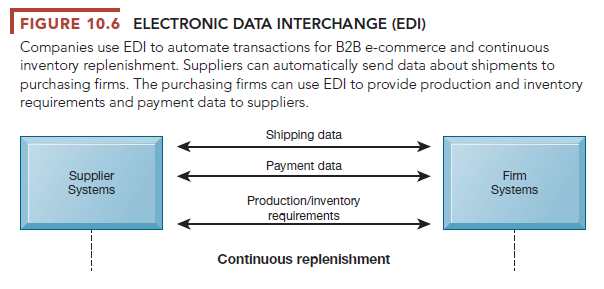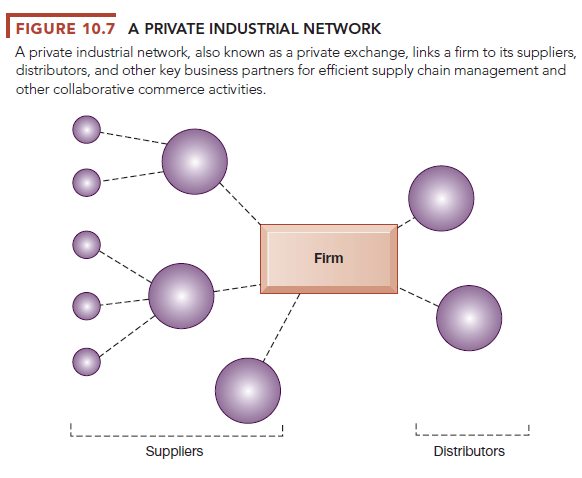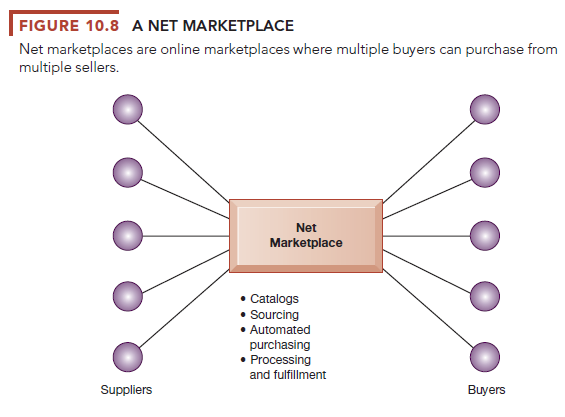Trade between business firms (business-to-business commerce, or B2B) represents a huge marketplace. The total amount of B2B trade in the United States in 2019 is estimated to be about $13.5 trillion, with B2B e-commerce (online B2B) contributing about $6.2 trillion of that amount (U.S. Bureau of the Census, 2018; authors’ estimates). By 2020, B2B e-commerce is expected to grow to about $6.9 trillion in the United States.
The process of conducting trade among business firms is complex and requires considerable human intervention; therefore, it consumes significant resources. Some firms estimate that each corporate purchase order for support products costs them, on average, at least $100 in administrative overhead, including processing paper, approving purchase decisions, using the telephone and fax machines to search for products and arrange for purchases, arranging for shipping, and receiving the goods. Across the economy, this adds up to trillions of dollars annually spent for procurement processes that could be automated. If even just a portion of inter-firm trade were automated and parts of the entire procurement process were assisted by the Internet, literally trillions of dollars might be released for more productive uses, consumer prices potentially would fall, productivity would increase, and the economic wealth of the nation would expand. This is the promise of B2B e-commerce. The challenge of B2B e-commerce is changing existing patterns and systems of procurement and designing and implementing new Internet and cloud-based B2B solutions.
1. Electronic Data Interchange (EDI)
B2B e-commerce refers to the commercial transactions that occur among business firms. Increasingly, these transactions are flowing through a variety of Internet-enabled mechanisms. About 80 percent of online B2B e-commerce is still based on proprietary systems for Electronic Data Interchange (EDI). EDI enables the computer-to-computer exchange between two organizations of standard transactions such as invoices, bills of lading, shipment schedules, or purchase orders. Transactions are automatically transmitted from one information system to another through a network, eliminating the printing and handling of paper at one end and the inputting of data at the other. Each major industry in the United States and much of the rest of the world has EDI standards that define the structure and information fields of electronic transactions for that industry.
EDI originally automated the exchange of documents such as purchase orders, invoices, and shipping notices. Although many companies still use EDI for document automation, firms engaged in just-in-time inventory replenishment and continuous production use EDI as a system for continuous replenishment. Suppliers have online access to selected parts of the purchasing firm’s production and delivery schedules and automatically ship materials and goods to meet prespecified targets without intervention by firm purchasing agents (see Figure 10.6).
Although many organizations still use private networks for EDI, they are increasingly web-enabled because Internet technology provides a much more flexible and low-cost platform for linking to other firms. Businesses can extend digital technology to a wider range of activities and broaden their circle of trading partners.

Procurement, for example, involves not only purchasing goods and materials but also sourcing, negotiating with suppliers, paying for goods, and making delivery arrangements. Businesses can now use the Internet to locate the lowest-cost supplier, search online catalogs of supplier products, negotiate with suppliers, place orders, make payments, and arrange transportation. They are not limited to partners linked by traditional EDI networks.
2. New Ways of B2B Buying and Selling
The Internet and web technology enable businesses to create electronic storefronts for selling to other businesses using the same techniques as used for B2C commerce. Alternatively, businesses can use Internet technology to create extranets or electronic marketplaces for linking to other businesses for purchase and sale transactions.
Private industrial networks typically consist of a large firm using a secure website to link to its suppliers and other key business partners (see Figure 10.7). The buyer owns the network, and it permits the firm and designated suppliers, distributors, and other business partners to share product design and development, marketing, production scheduling, inventory management, and unstructured communication, including graphics and email. Another term for a private industrial network is a private exchange.
An example is VW Group Supply, which links the Volkswagen Group and its suppliers. VW Group Supply handles 90 percent of all global purchasing for Volkswagen, including all automotive and parts components.
Net marketplaces, which are sometimes called e-hubs, provide a single, digital marketplace based on Internet technology for many buyers and sellers (see Figure 10.8). They are industry-owned or operate as independent intermediaries between buyers and sellers. Net marketplaces generate revenue from purchase and sale transactions and other services provided to clients. Participants in Net marketplaces can establish prices through online negotiations, auctions, or requests for quotations, or they can use fixed prices.


There are many types of Net marketplaces and ways of classifying them. Some sell direct goods and some sell indirect goods. Direct goods are goods used in a production process, such as sheet steel for auto body production. Indirect goods are all other goods not directly involved in the production process, such as office supplies or products for maintenance and repair. Some Net marketplaces support contractual purchasing based on long-term relationships with designated suppliers, and others support short-term spot purchasing, where goods are purchased based on immediate needs, often from many suppliers.
Some Net marketplaces serve vertical markets for specific industries, such as automobiles, telecommunications, or machine tools, whereas others serve horizontal markets for goods and services that can be found in many industries, such as office equipment or transportation.
Exostar is an example of an industry-owned Net marketplace, focusing on long-term contract purchasing relationships and on providing common networks and computing platforms for reducing supply chain inefficiencies. This aerospace and defense industry-sponsored Net marketplace was founded jointly by BAE Systems, Boeing, Lockheed Martin, Raytheon, and Rolls-Royce plc to connect these companies to their suppliers and facilitate collaboration. More than 125,000 trading partners in the commercial, military, and government sectors use Exostar’s sourcing, e-procurement, and collaboration tools for both direct and indirect goods.
Exchanges are independently owned third-party Net marketplaces that connect thousands of suppliers and buyers for spot purchasing. Many exchanges provide vertical markets for a single industry, such as food, electronics, or industrial equipment, and they primarily deal with direct inputs. For example, Go2Paper enables a spot market for paper, board, and craft among buyers and sellers in the paper industries from more than 75 countries.
Exchanges proliferated during the early years of e-commerce, but many have failed. Suppliers were reluctant to participate because the exchanges encouraged competitive bidding that drove prices down and did not offer any long-term relationships with buyers or services to make lowering prices worthwhile. Many essential direct purchases are not conducted on a spot basis because they require contracts and consideration of issues such as delivery timing, customization, and quality of products.
Source: Laudon Kenneth C., Laudon Jane Price (2020), Management Information Systems: Managing the Digital Firm, Pearson; 16th edition.

I get pleasure from, cause I found exactly what I was taking a look for. You have ended my four day lengthy hunt! God Bless you man. Have a great day. Bye